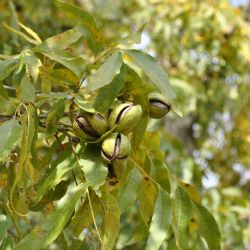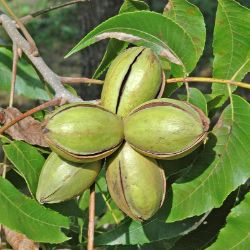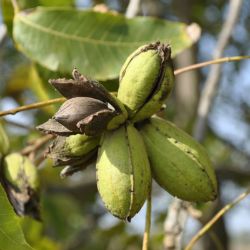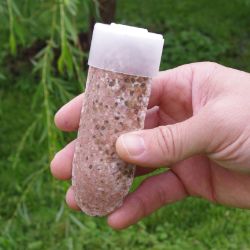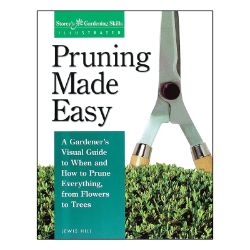Pest & Disease Control for Pecan Trees
Every tree has the future potential for disease and insect damage. Factors such as location and weather will play a part in which issues your tree encounters. If available, disease-resistant trees are the best option for easy care; and for all trees, proper maintenance (such as watering, fertilizing, pruning, spraying, weeding, and fall cleanup) can help keep most insects and diseases at bay.
NOTE: This is part 7 in a series of 11 articles. For a complete background on how to grow pecan trees, we recommend starting from the beginning.
Crown Gall
Trees appear stunted and slow growing; leaves may be reduced in size, little or no fruit. If tree is dead, inspect roots for hard, woody ‘tumors’. Note: many things can cause stunted trees.
Control
- Consult County Extension Agent
Scab
Appear as small circular, olive-green spots that turn black on new leaves, leaf petioles and nut shuck tissue. Lesions expand and may coalesce, then fall out giving a shot hole appearance. Early infections may cause premature nut drop, but more commonly cause shuck to stick to nut surface (stick tights). Late infections can prevent nuts from fully expanding and decrease nut size.
Natural Control
- Monterey Fruit Tree Spray Plus
Aphids
They are the size of a pinhead and vary in color depending on the species. Cluster on stems and under leaves, sucking plant juices. Leaves then curl, thicken, yellow and die. Produce large amounts of a liquid waste called “honeydew”. Aphid sticky residue becomes a growth media for sooty mold.
Natural Control
- Safer® Brand Insect Killing Soap
- Monterey Fruit Tree Spray Plus
Pecan Nut Casebearer
Eggs are minute and change from white to pink. Larvae change from olive-gray to gray-brown and measure 1/2”, reddish brown head and sparsely covered with fine, white hairs. Adult moths are slate-gray with ridge of long, dark scales on laser end of forewings. They are 1/3” long with wingspan of almost an inch.
Larvae leave cocoon (located at junction of bud and stem) in early spring about time buds open, feed for about 2 weeks on exterior of opening buds. Then bore into tender shoots where they mature. Late May to early June, about time for pollination to occur, adults emerge and lay eggs on young nuts. 8-9 days later eggs hatch and larvae bore into nuts at stem end. Infested nuts are held together by frass and webbing and larvae feed inside nut for 3-4 weeks, pupates and 2nd generation of adults emerge in mid-July (in Missouri) and the cycle is repeated. A third generation of adults emerges in late August and September and larvae feed in nut shuck and on the leaves.
First generation is most damaging. Treat when all catkins have fallen and tips of nuts turn brown (after pollination), early June in Missouri. Timing is important and varies from year to year and from area to area.
Control
- Consult County Extension Agent
Brown Leaf Spot
This is common in southern areas with high rainfall and neglected orchards. Reddish-brown spots often with gray rings. Can cause early leaf drop in fall, weakening tree.
Control
- Consult County Extension Agent
Powdery Mildew
Appears as whitish-gray powdery mold or felt-like patches on leaves and nuts. Leaves may fall off early and on nuts, shucks split and kernels shrivel.
Natural Control
- Monterey Fruit Tree Spray Plus
Borers
Appears as a thick, gummy substance (SAP) leaking from round holes on the trunk or in crotch of the tree. Worms with brown heads and cream-colored bodies tunnel through trunk that will kill the tree. Once infested, use a fine wire to try to mash them or dig them out.
Natural Control
- Dig out with thin wire or mash
Chemical Control
- GardenTech® Sevin® Bug Killer
Sticky Shuck
During nut development when water begins to fill the nut. Part of the shuck turns black; nuts will not be completely filled.
Control
- Consult County Extension Agent
Fall Webworm
Damage the leaves by both feeding and web building. Webworms over-winter within cocoons located in protected places, such as crevices in bark or under debris and fences. Adult moths emerge in summer. They have a wingspan of about 1 1/4" and vary from pure satiny white to white thickly spotted with small dark brown dots. Females lay white masses of 400-500 eggs on the undersides of the leaves. The caterpillars hatch in 10 days and all from the same egg mass live together as a colony. They spin webs that enclose the leaves, usually at the end of a branch, to feed upon them. After they have defoliated a branch, they extend their nest to include additional foliage.
When caterpillars are mature, they leave the nest to seek a place to spin gray cocoons. The mature caterpillars are about 1 1/4" long with a broad dark brown stripe along the back, and yellowish sides thickly peppered with small blackish dots. Each segment is crossed by a row of tubercles with long light brown hairs.
Natural Control
- Hi-Yield® Vegetable & Ornamental Insect Control
- Natural Guard® Caterpillar Killer Spray w/BT
- Remove web with rake and burn or prune out
Pecan Weevil
Larvae are creamy-white grubs, C-shaped with reddish-brown heads and 1/2” long. Adult moths are light brown to gray and are about 1/2” long. The adult emerges as early as July 15 (Missouri), feed on nuts before they are completely formed, causing them to shrivel, the nut blacken and drop. Nuts may show a tiny, dark puncture wound extending through the shuck and unhardened shell. If larvae is found inside the nut before the shell hardens, indicates damage from other insect, usually nut curculio or hickory shuck worm.
The adult lays 2-4 eggs in separate pockets within each kernel. Grubs hatch in late August and feed for about a month then exit thru a hole about 1/8” beginning in late September. Pecan weevils remain in larval stage for 1-2 years 4-12” underground. They pupate in early autumn and become adults in about 3 weeks. The adults remain in the soil until the following summer. Complete life cycle is 2-3 years. Do not move very far from the tree under which they emerge, so certain trees may be infested while trees nearby are not bothered. Can be controlled with insecticide, but ours are not recommended.
Control
- Consult County Extension Agent
Pecan Phylloxera
Appears as a small aphid-like insect that is seldom seen, but produces galls that are easily visible. Severe infestations cause malformed, weakened shoots that finally die and can even kill entire limbs. The insect over winters as eggs in the dead body of female adult in protected places on the branches of pecan trees. After bud break the eggs hatch and the insects feed on opening buds or leaf tissue. These are known as ‘stem mothers’. Their feeding stimulates the development of galls, which enclose the insect in a few days. The stem mother matures inside the gall and lays eggs, which emerge in mid-summer as adults and continue the cycle. Only need to treat when galls are in large numbers on shoots or nuts.
Control
- Consult County Extension Agent
Nut Curculio
Adults are dark-gray to reddish-brown, 3/16” long, larvae are legless, creamy-white, 3/16” long and found within immature pecans. The adults attack immature pecans from mid-July to mid-August. Make punctures in the shucks where they deposit an egg. Eggs hatch in 4-5 days and the larvae feed for 10-14 days. This causes a bleeding of brown sap on the shuck and also premature nut drop. Larvae exit from a small hole and enter the soil. Adult emerges 4 weeks later, in September and October and over winters in ground trash.
Control
- Consult County Extension Agent
Hickory Shuckworm
Adult moths are dark-gray nocturnal flyers, 3/8” long. Larvae are creamy-white with brownish heads, 3/8” long. Pupae, found within the shuck, are dark brown and up to 1/3” long. When larvae feed in the interior of the nut, mid-July until shell hardening in mid-August, premature nut drop can occur. Larvae pupate in the nuts and third generation moths emerge in early August. Damage from Hickory Shuck worms can be eliminated if insecticide sprays can control these moths.
Natural Control
- Hi-Yield® Vegetable & Ornamental Insect Control
Navel Orangeworm
Caterpillar is ¾ inch long, reddish orange to yellow. Adult moths have irregular, silver gray and black forewings and legs, snout like at front of the head. Eggs are white at first and later orange before hatching. Larvae are reddish orange then vary from milky white to pink. Pupae are light to dark brown. Larvae bore into nutmeat and later consume most of the nut. Producing large amounts of webbing and a fine powdery residue. They will over winter in mummy nuts in tree or on the ground.
Natural Control
- Hi-Yield® Vegetable & Ornamental Insect Control
Chemical Control
- GardenTech® Sevin® Bug Killer
Peach Twig Borers
Adults of this insect are clearwing moths, metallic blue to black in color with bright bands of orange or yellow. They are about 13 mm long with wings folded and their forewings have a black apical band. Larvae are about 18 mm long, white with brown heads.
Symptoms:
- Build up of reddish brown frass and gummy exudates known as gummosis. Check branch crotches on larger branches or upper trunk.
- Heavy infestation may cause branch dieback.
- Young tree maybe girdled and killed older trees may be weakened.
Natural Control
- Hi-Yield® Vegetable & Ornamental Insect Control
Chemical Control
- GardenTech® Sevin® Bug Killer













